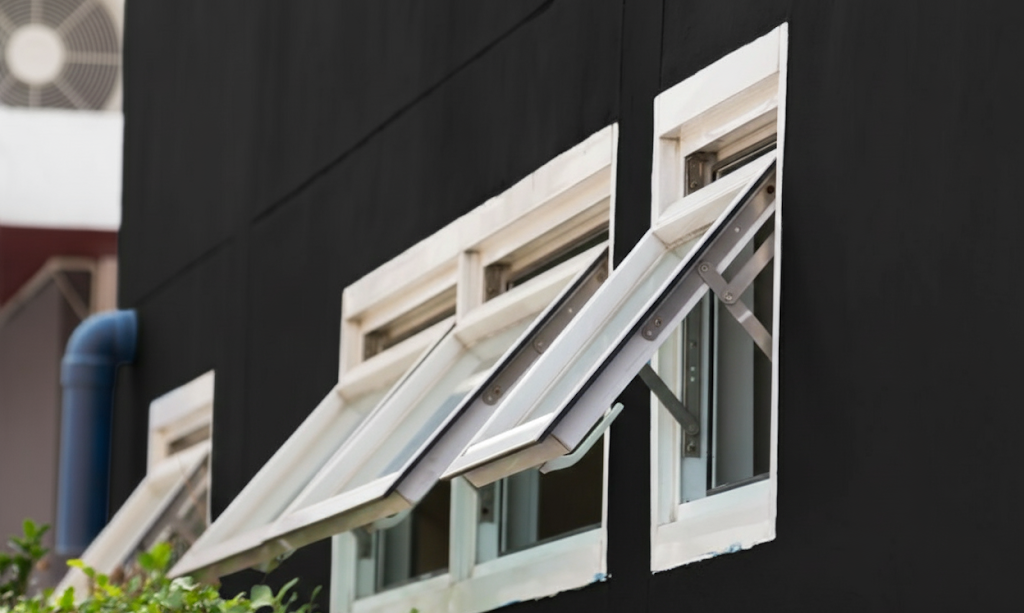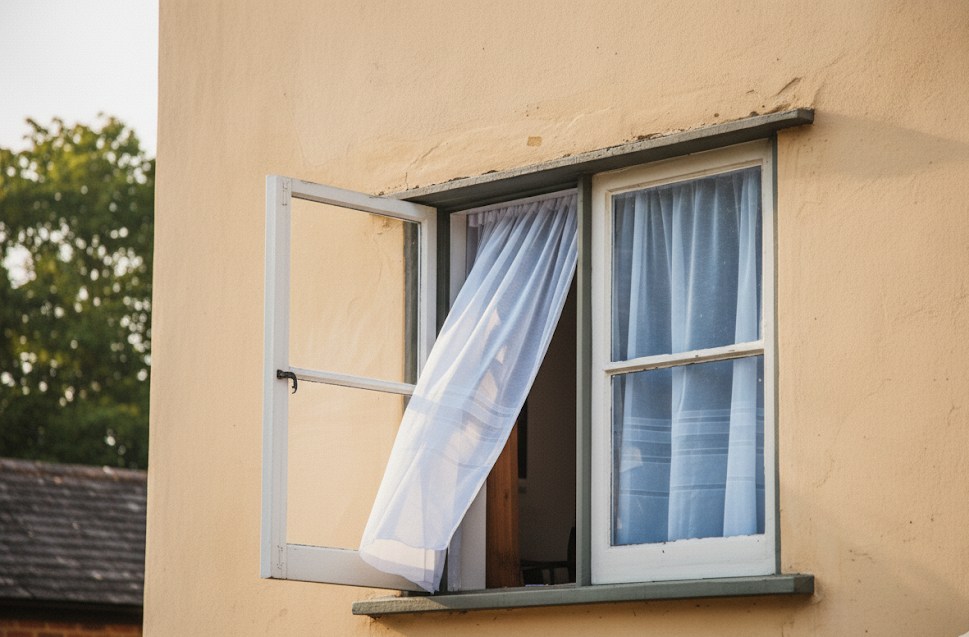Key Takeaways:
- uPVC awning windows are top-hinged, allow rainproof ventilation, and suit bathrooms, basements, and sunrooms.
- uPVC casement windows are side-hinged, maximize airflow, meet bedroom egress codes, and provide unobstructed views.
- Casements offer superior energy efficiency with multi-point locks, while awnings provide moderate airflow and privacy-focused design.
- Installers often favor casements for easier installation, but true value depends on placement, aesthetics, ventilation, and code compliance.
At first glance, uPVC awning windows and uPVC casement windows may seem like interchangeable choices, but their differences go far beyond the way they open. Each design brings distinct advantages in airflow, insulation, and functionality that can influence comfort, aesthetics, and compliance with building standards.
What many installers don’t emphasize is how these details affect long-term performance and placement within a project. From ventilation during rain to egress requirements in living spaces, understanding the strengths and limitations of both window types is key to making the right decision for any residential or commercial build.
Understanding the Window Types
What Is a uPVC Awning Window?

- Design: Hinged at the top, opens outward from the bottom.
- Primary Functions:
- Allows ventilation during rain (window acts like a shield).
- Enhances privacy with limited openings.
- Best Suited For: Bathrooms, basements, sunrooms.
- Architectural Character: Horizontal, modern, discreet.
What Is a uPVC Casement Window?

- Design: Hinged on the side, swings outward like a door.
- Primary Functions:
- Maximizes ventilation.
- Provides wide, unobstructed views.
- Best Suited For: Bedrooms (egress), kitchens (ventilation), living areas (views).
- Architectural Character: Vertical, classic, versatile.
Side-by-Side Comparison: Awning vs Casement
Here’s a reader-friendly breakdown that highlights the real-world differences most installers overlook:
| Attribute | ||
| Design | Top-hinged, opens bottom-outward | Side-hinged, opens outward like a door |
| Ventilation | Moderate; good even during rain | Excellent; captures cross-breezes |
| Energy Efficiency | Good tight seal | Superior with multi-point locks |
| Safety / Egress | Limited escape potential; safer in basements | Egress compliant for bedrooms |
| Maintenance | Harder to clean; hinge upkeep | Easier to clean; crank wear risk |
| Aesthetic | Modern, horizontal, privacy-focused | Classic/versatile, wide-open view |
| Cost | Higher (complex installation) | Lower (simpler installation) |
| Limitations | Cleaning difficulty, limited airflow, hazard if low-set | Needs clearance outdoors, crank wear, wind risk |
| Best Locations | Bathrooms, basements, sunrooms | Bedrooms, kitchens, living rooms |
Performance Attributes Installers Rarely Mention
Ventilation Dynamics
- Awning: Works well in wet climates since you can keep them open in rain. However, airflow is less dynamic.
- Casement: Acts like a “ventilation scoop,” directing breezes into the home. Critical in hot climates.
Energy Efficiency
- Both benefit from uPVC’s natural insulation.
- Casement has the advantage with multi-point locking systems creating an airtight seal.
Safety and Code Compliance
- Casement windows are often required for bedroom egress under building codes.
- Awning windows are safer for basements, where break-ins or flooding are concerns.
Maintenance Realities
- Awning windows: More difficult to clean from inside, especially on upper floors. Hinges can collect debris.
- Casement windows: Easier to wipe both sides but crank mechanisms need occasional replacement.
Architectural and Aesthetic Considerations
- Awning: Clean, modern look with narrow horizontal lines. Suits minimalist or privacy-focused designs.
- Casement: Timeless, vertical, works across architectural styles. Great for framing outdoor views.
What installers won’t tell you: Poor window-type selection can break architectural rhythm. Imagine horizontal awnings interrupting a vertical facade or vice versa. This isn’t just about function, it’s about proportion and design integrity.
Cost and Long-Term ROI
- Awning: Typically higher initial installation cost due to complex sealing.
- Casement: More affordable to install but carries risk of crank replacements over time.
Hidden installer insight: Many push casements as “cheaper upfront,” ignoring the fact that hardware wear (cranks, seals) may increase lifecycle costs.
Placement Suitability
- Awning Windows:
- Basements → security and rain ventilation.
- Bathrooms → privacy and moisture control.
- Sunrooms → controlled, filtered airflow.
- Casement Windows:
- Bedrooms → emergency egress.
- Kitchens → maximum ventilation, especially near stoves.
- Living areas → unobstructed views.
Often, the best projects combine both window types strategically rather than committing to just one.
The uPVC Advantage
No matter which type you choose, uPVC frames provide:
- Durability: Resistant to warping, corrosion, and fading suitable for varied global climates.
- Energy Savings: Naturally insulating, reduces HVAC reliance.
- Low Maintenance: Easy cleaning, long-lasting finish.
Type-specific considerations in uPVC:
- Awning: Cleaning difficulty persists, though frame durability is high.
- Casement: Hardware (crank) remains the weak link, though uPVC strengthens the frame.
What Most Installers Won’t Tell You
- Their bias: Installers may push casements because they’re easier and faster to install not necessarily better for your project.
- Your reality: True value depends on airflow strategy, facade design, and code compliance.
- The solution: Partner with a manufacturer like Oridow, who provides not only both types but also custom dimensions, finishes, and global certifications.
For Wholesalers, Builders, and Architects
- Informational intent: Understand exact performance trade-offs.
- Navigational intent: Explore Oridow’s uPVC window systems.
- Transactional intent: Bulk orders with customization (glazing, color, size) tailored to your project’s architectural vision.
Conclusion
Both uPVC awning and uPVC casement windows deliver distinct benefits. The real question isn’t “Which is cheaper to install?” but rather:
- Does your design demand privacy or openness?
- Does code require egress or security?
- Will long-term maintenance outpace short-term cost savings?
With Oridow’s expertise, certifications, and global project portfolio, you can move beyond installer shortcuts and choose windows that truly align with your project’s vision.
FAQs:
Are uPVC awning windows more expensive than casement windows?
- Yes, awning windows usually cost more due to complex installation and sealing. Casement windows are more affordable upfront but may require crank replacements over time.
Can uPVC casement windows be used in bedrooms for egress?
- Yes. Casement windows are egress-compliant and often required in bedrooms by building codes, unlike awning windows which offer limited escape potential.
Which type of window is easier to maintain: awning or casement?
- Casement windows are easier to clean from inside the house, while awning windows are harder to access for cleaning. However, casements have cranks that can wear out over time.
Do awning windows provide enough airflow compared to casement windows?
- Awning windows allow moderate airflow, even in rainy conditions, but casement windows provide maximum ventilation and cross-breezes, making them superior in hot climates.
Why choose uPVC over aluminum for awning and casement windows?
- uPVC is low-maintenance, energy-efficient, and resists corrosion or warping. It is especially valuable in humid or coastal environments where aluminum may deteriorate faster.
Where are uPVC awning and casement windows best installed?
- Awning windows suit basements, bathrooms, and sunrooms (privacy and moisture control). Casement windows work best in kitchens, bedrooms, and living rooms where airflow and egress are critical.





